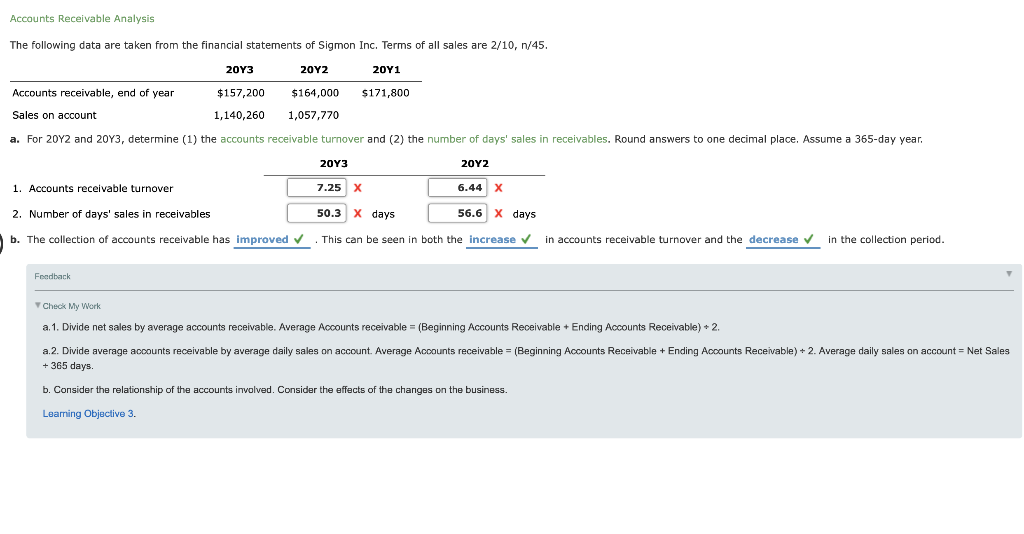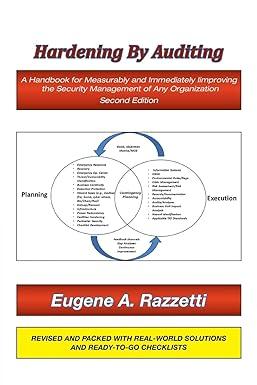Question
Accounts Receivable Analysis The following data are taken from the financial statements of Sigmon Inc. Terms of all sales are 2/10, n/45. 20Y3 20Y2 20Y1
Accounts Receivable Analysis
The following data are taken from the financial statements of Sigmon Inc. Terms of all sales are 2/10, n/45.
| 20Y3 | 20Y2 | 20Y1 | ||||
| Accounts receivable, end of year | $157,200 | $164,000 | $171,800 | |||
| Sales on account | 1,140,260 | 1,057,770 | ||||
a. For 20Y2 and 20Y3, determine (1) the accounts receivable turnover and (2) the number of days' sales in receivables. Round answers to one decimal place. Assume a 365-day year.
| 20Y3 | 20Y2 | |||
| 1. Accounts receivable turnover | ||||
| 2. Number of days' sales in receivables | days | days | ||
b. The collection of accounts receivable has improved . This can be seen in both the increase in accounts receivable turnover and the decrease in the collection period.
Feedback
HELP! I don't know what I am doing wrong- please share feedback, answer, and how you got to the answer. Thanks.
a.1. Divide net sales by average accounts receivable. Average Accounts receivable = (Beginning Accounts Receivable + Ending Accounts Receivable) 2.
a.2. Divide average accounts receivable by average daily sales on account. Average Accounts receivable = (Beginning Accounts Receivable + Ending Accounts Receivable) 2. Average daily sales on account = Net Sales 365 days.
b. Consider the relationship of the accounts involved. Consider the effects of the changes on the business.
Learning Objective 3.
Accounts Receivable Analysis The following data are taken from the financial statements of Sigmon Inc. Terms of all sales are 2/10, n/45. 20Y3 2012 2011 Accounts receivable, end of year $164,000 $171,800 $157,200 1,140,260 Sales on account 1,057,770 a. For 2072 and 20Y3, determine (1) the accounts receivable turnover and (2) the number of days' sales in receivables. Round answers to one decimal place. Assume a 365-day year. 20Y3 20Y2 1. Accounts receivable turnover 7.25 x 6.44 x 2. Number of days' sales in receivables 50.3 X days 56.6 X days b. The collection of accounts receivable has improved This can be seen in both the increase in accounts receivable turnover and the decrease in the collection period. Feedback Check My Work a. 1. Divide net sales by average accounts receivable. Average Accounts receivable = (Beginning Accounts Receivable + Ending Accounts Receivable) +2. a.2. Divide average accounts receivable by average daily sales on account. Average Accounts receivable = (Beginning Accounts Receivable + Ending Accounts Receivable) + 2. Average daily sales on account = Net Sales + 365 days. b. Consider the relationship of the accounts involved. Consider the effects of the changes on the business. Leaming Objective 3Step by Step Solution
There are 3 Steps involved in it
Step: 1

Get Instant Access to Expert-Tailored Solutions
See step-by-step solutions with expert insights and AI powered tools for academic success
Step: 2

Step: 3

Ace Your Homework with AI
Get the answers you need in no time with our AI-driven, step-by-step assistance
Get Started


